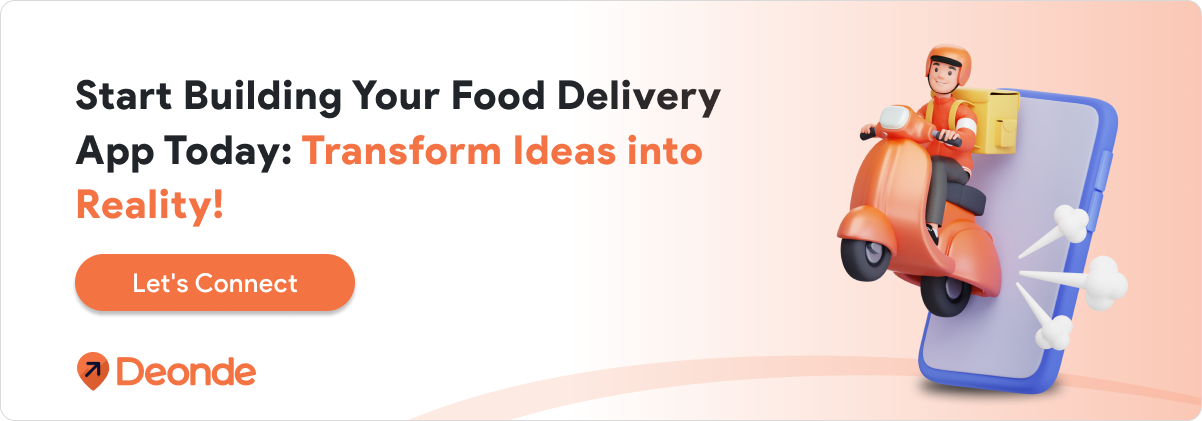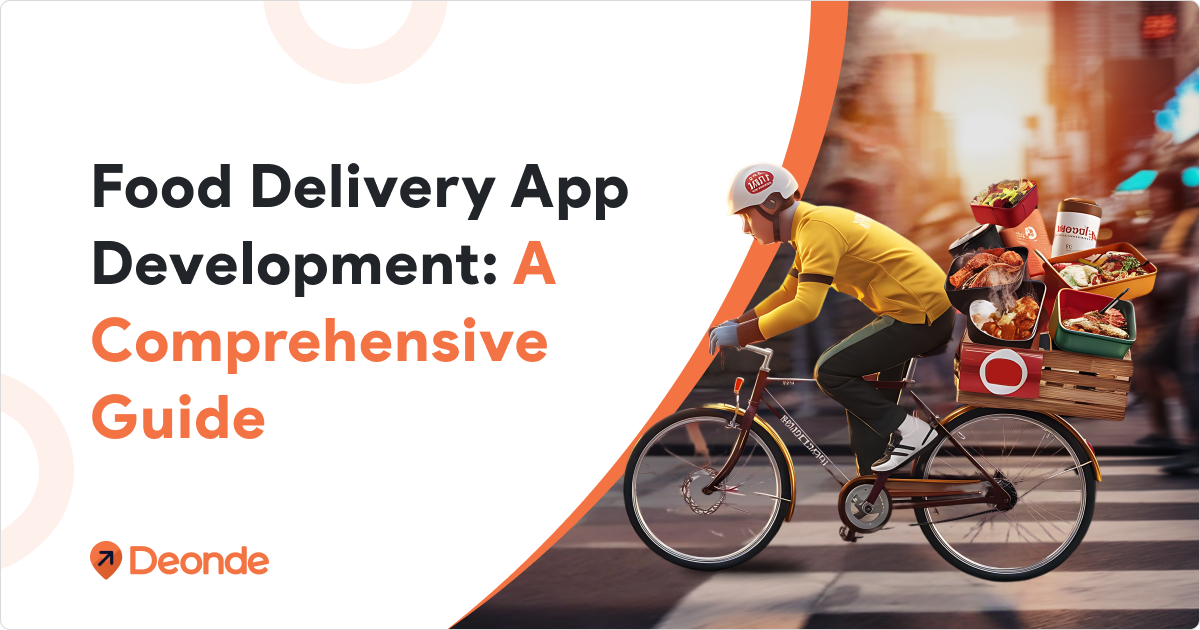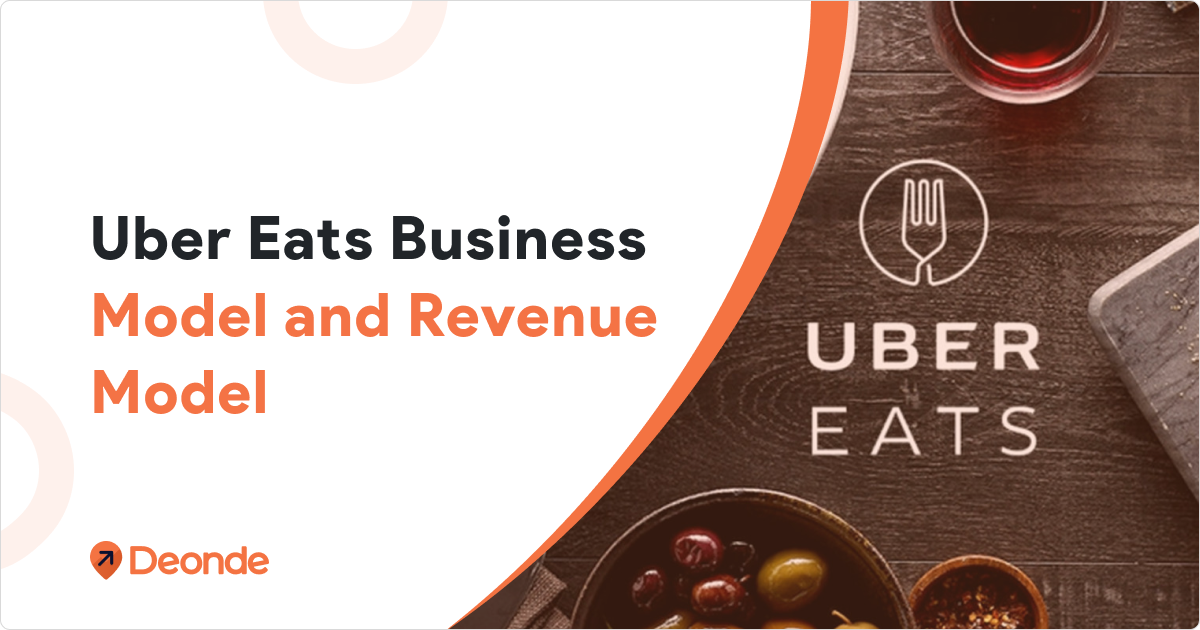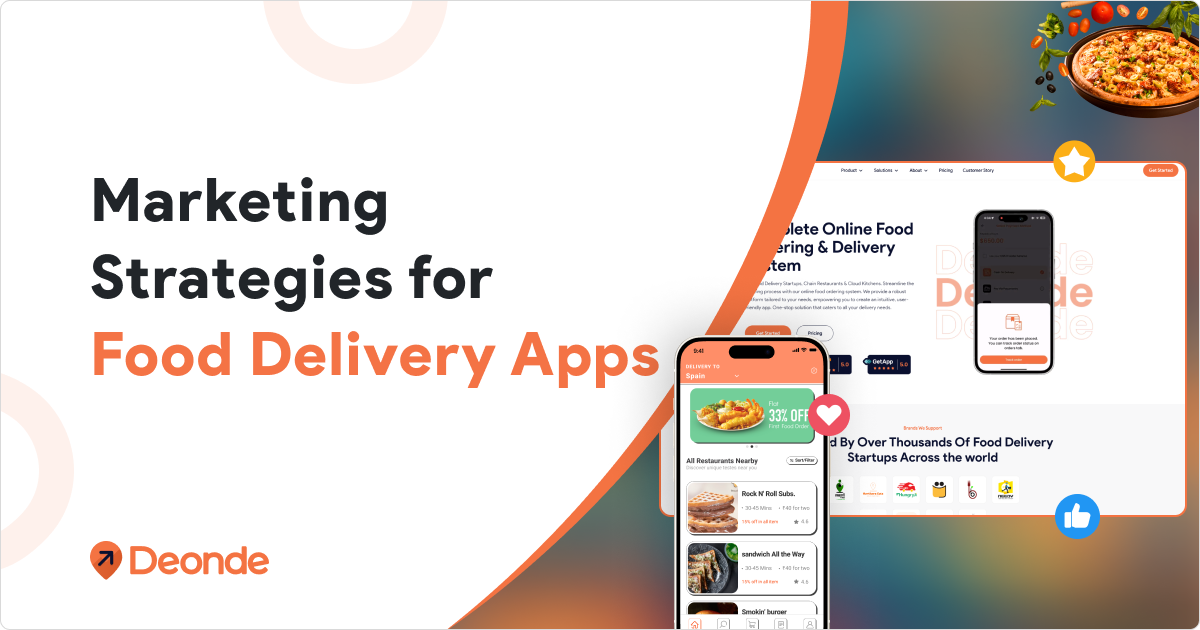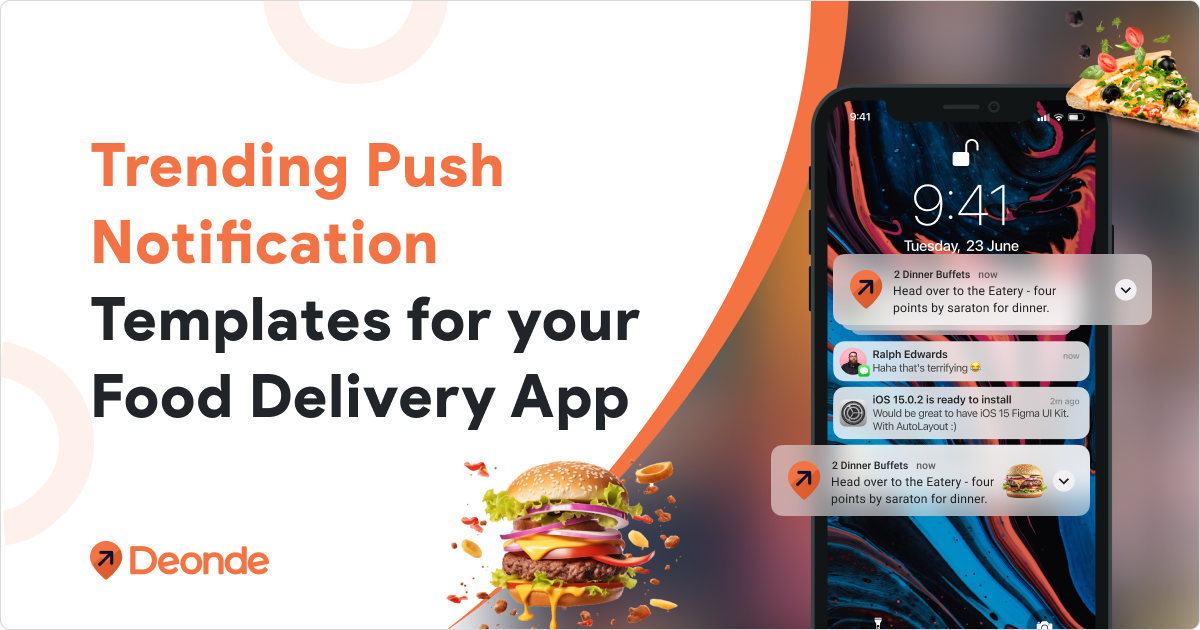Are you considering launching your on-demand food delivery business in 2024 but don’t know how to start? Then this food delivery app development guide is for you.
In this guide, we’ll discuss everything you need to launch your food delivery app—the what, the whys, and the hows!
Along with a step-by-step explanation of how to develop a food delivery app from the ground up, we offer insights into Food Delivery Software Solutions, revenue models, and food delivery market trends.
Excited? Then let’s get started:
What Exactly is a Food Delivery App?
As soon as we hear the words food delivery apps, we immediately start thinking of brands like Zomato, Swiggy, Uber Eats, and Grubhub.
Don’t we? But what exactly are these apps?
A food delivery app, usually mobile, connects its users to multiple local eateries and restaurants.
This interface allows app users to browse menus, order their favorite food items, and deliver them to their homes—without getting up from the couch!
How Does a Food Delivery Mobile App Work?
A food delivery mobile app works through a series of steps involving users and stakeholders, such as restaurants, delivery drivers, and the app platform. Here’s a simplified breakdown of How Online Food Delivery App Works:
Users must download the food delivery app onto their mobile phones to access these services.
Once this is done, users must register and complete their profiles to continue browsing and ordering food. Users can also track their food orders in real-time and receive updates through push notifications.
On the other hand, restaurants (food makers) partner with food delivery apps to list their menus and receive orders. The restaurants listed on the app then fulfill the orders the app users place.
Finally, delivery drivers complete the last leg of the food delivery process by carrying restaurant-ready meals to the users.
During transactions, the food delivery app typically takes a commission on every order placed through the app. Additionally, it can generate revenue through advertising and premium placements.
In a way, these food delivery apps facilitate interactions among app users, restaurants, and delivery drivers for a seamless experience. These apps have brought a sense of convenience to all our lives to the point where we can’t do without them!
Consequently, this has allowed the business of food delivery apps to grow exponentially. Take a look at the staggering industry statistics below:
The Rise of Food Delivery Apps ( Market Overview )
Did you know? The food delivery industry in the USA has tripled in revenue since 2019.
In 2015, nearly 66 million Americans spent $8.7 billion ordering food through delivery apps.
Don’t be surprised yet! These numbers spiked through the roof in 2020 when 111 million food delivery application users in the USA ordered $26 billion worth of restaurant-ready food.
When we talk about the business of food delivery apps—the sky’s the limit!
The global food delivery app statistics show that this sector is promising and here to stay! A consumer trend report conducted in 2021 states that 53% of adults believe that food delivery apps have now become essential to their lives!
This shift from on-premise food sales to off-premise delivery was necessary for the rise of food delivery apps.
Today, consumers expect fast and hassle-free food delivery services. As a result, more and more restaurants are partnering with food delivery platforms to reach a wider consumer segment.
Food Delivery App Business and Revenue Model
By now, you know that the business of food delivery apps is lucrative. There is plenty of opportunity to grow in this market.
But how are these food delivery apps making money?
Some Food Delivery Business and Revenue Models and strategies come into play. Here are a few to get you started:

1. Commissions on Orders
This is the primary source of income for most food delivery apps.
The app charges a modest commission from restaurants on every order. The exact percentage of commissions earned by the app varies depending on the area of operation and restaurants.
However, the food delivery app commissions usually amount to 15%-30% of the average order value.
2. Delivery Fees
While restaurants charge commission fees, users also pay a little extra on each order in delivery or convenience fees.
These delivery fees are dynamic. You may be charged a greater fee if you’re ordering during rush hours or if you’re ordering from a restaurant that’s pretty far away.
3. Subscription Fees
Apps like Zomato and Swiggy offer premium subscriptions to users. Under these subscriptions, users pay a fixed monthly amount for perks like free deliveries, exclusive discounts, or priority access to top restaurants.
For example, Zomato’s Gold exclusive loyalty program offers free deliveries and mega-discounts to its subscribers.
4. Advertising
Food delivery apps usually have multiple restaurant vendors—some even selling the same type of cuisine.
Consequently, some restaurants may choose to promote their products and services. To make this happen, food delivery apps generally offer advertising and premium placement services to restaurants.
With these services, restaurants can improve their visibility and get more orders. The food delivery app generates ample revenue through such in-app advertising.
5. Booking and Ticketing
Some food delivery apps may also offer booking and ticketing services for major social events, such as live concerts or comedy talk shows.
For instance, Zomato launched Zomoland, India’s largest food and entertainment carnival. Through the Zomato app, users could buy all-inclusive tickets that included access to live concerts, food, and drinks.
Essential Key Features of the Food Delivery App
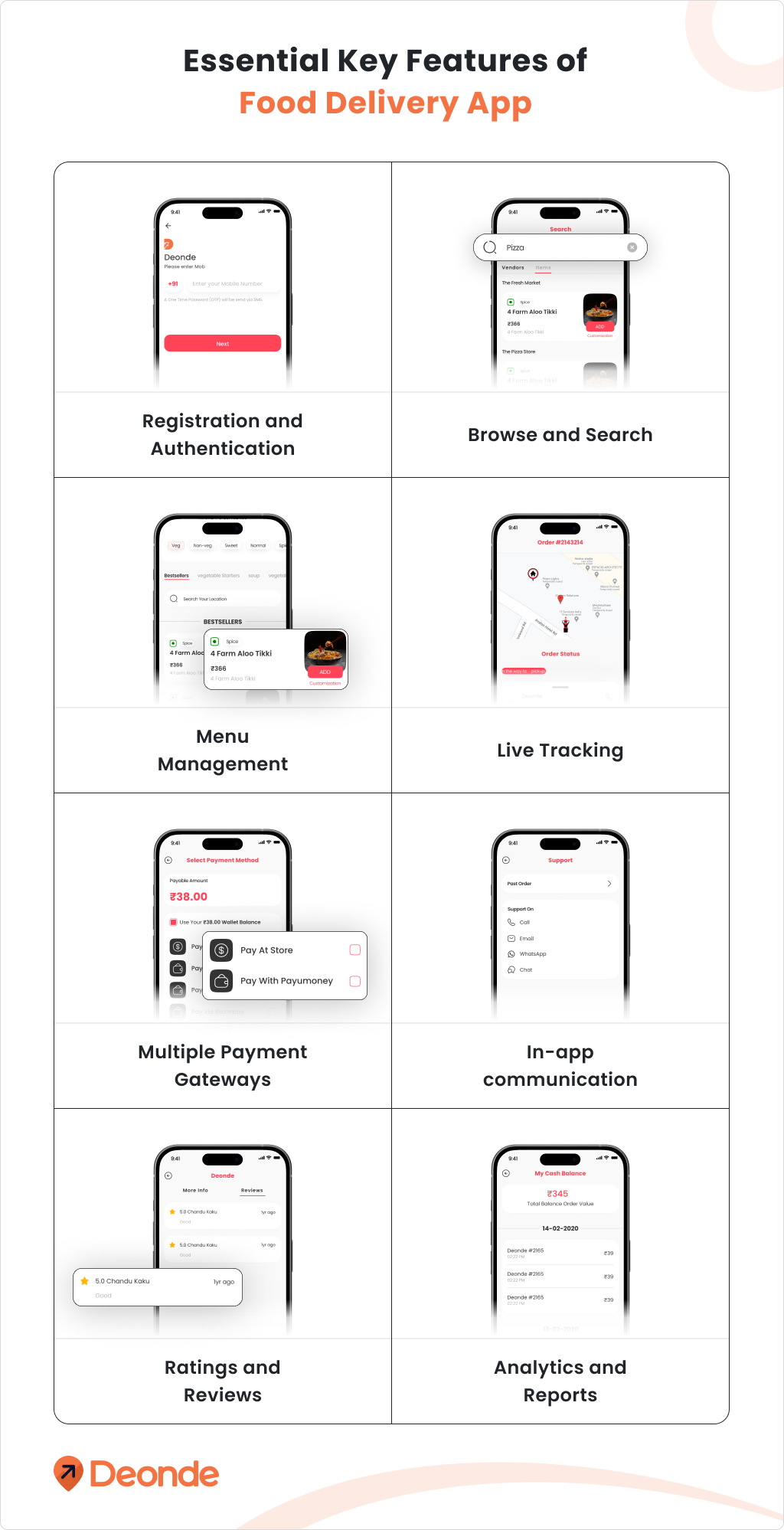
Your food delivery app will be nothing more than an empty wireframe without functional features. Core features like browsing, search and filter, registration, menu management, live-tracking, and in-app communication are a must to enhance user experiences.
Here are some core features for your food delivery app—that you cannot miss!
1. Registration and Authentication
Allow users to create their profiles using email or a phone number. Simplify the registration process and implement two-factor or biometric authentication to safeguard personal information.
2. Browse and Search
With multiple restaurant vendors on your food delivery app, consumers will have difficulty browsing for their chosen meal.
Using the search and filter features, you can expedite browsing times. You can sort the restaurants based on cuisine type, operational hours, price range, ratings, veg/non-veg, and delivery options.
Doing so will help users find what they’re looking for quickly.
3. Menu Management
Allow restaurants to edit, delete, or add food items & tags to their menus.
Menus with relevant food images, pricing, and meaningful categorization tend to be easy on the eye. Hence, restaurant vendors have the tools they need to manage & optimize their menus.
4. Live Tracking
Customers expect transparency when they place orders through food delivery apps, and implementing the live-tracking feature can assist this expectation. Customers can see their orders processed, prepared, dispatched, and delivered in real time.
5. Multiple Payment Gateways
For secure and convenient transactions, include multiple payment options like debit/credit cards, UPI, or cash on delivery. Implement strong encryption and compliance standards—for utmost data privacy and security.
6. In-app communication
In-app Chat Notification Solution features allow users or delivery drivers to seek assistance and resolve real-time issues. Hence providing a fuller, more satisfied experience for all.
7. Ratings and Reviews
Make your app users feel heard. Supplement your food delivery app with a ratings and reviews system. Here, verified users can share their feedback with the restaurants. They can comment on the food quality, delivery speed, and overall customer service.
8. Analytics and Reports
Provide restaurant vendors and delivery drivers with an intuitive dashboard. This will lend them unique Analytics and Management Solutions. They can track their earnings, orders, deliveries, customer ratings, and more.
By understanding these KPIs, restaurants, and delivery drivers can identify their shortcomings and quickly improve to increase revenues.
Step-by-step Process of Food Delivery App Development Guide
Extensive research, choosing the right business model, customizing app features, integrating third-party services, testing, debugging, marketing, and more are needed.
Let’s break down the process of food delivery app development:

1. Conduct Comprehensive Research
[ A ] Consumer Research
Identify your target consumer. Understand consumer demographics and map out an ideal consumer profile. Think about your user. What’s their age? What’s their income level? How would they primarily use your app? Why do they need a food delivery app? Where are they located?
Identifying your consumer will allow you to study their online browsing and consumption habits. You’ll also be able to leverage the consumer pain points and develop a food delivery app that can help them.
[ B ] Market Research
Analyze the competitive landscape of food delivery apps and follow up with key trends. Evaluate the revenue models and marketing strategies of industry leaders like Zomato or Swiggy!
By doing so, you’ll be able to stumble across several areas where you can drive innovation and growth. Find your unique vertical by targeting an untapped vertical.
2. Selecting the Optimal Business Model
Now that you’ve gained some insight into your target consumer and the market ask yourself: How much are they currently paying, and how much will they be willing to pay?
The answer to this question will lead you to choose a revenue model that will work best for your business.
You can either go for a commission-based food delivery app, a subscription-based or a mix of both. However, this decision will entirely depend on your potential customers, acquisition costs, and net profit margins.
3. Understanding the Technology Stack
A tech stack is a set of tools to develop and run a mobile app. It includes programming languages, frameworks, libraries, and databases. Your food delivery app will entail front-end and back-end development. You’ll also need to explore storage options:
[ A ] Front-end Development
This is centered on creating the app’s elements with which the user will interact. Examples include restaurant menus, navigation buttons, add-to-cart, and registration forms.
Usually, an open-source framework like React Native is used to develop mobile apps for both iOS and Android platforms.
[ B ] Back-end Development
Data processing and communication occur in server-side development, which also involves managing all the back-end operations that keep the app running.
For back-end development, languages like Python, Ruby on Rails, or Node.js are typically used.
[ C] Database
Choosing the right database is crucial to app performance and scalability.
A database is where all your app’s data will be stored. Relational databases like MySQL or PostgreSQL work best for structured data sets like user accounts or order details.
4. Custom UI and UX
The touch and feel of your on-demand food delivery app can make or break your business. Your interface design must align with your brand’s colors, font, and style. Doing so will not only make your app engaging but also more recognizable.
The design process usually starts with wireframing and prototyping. Here, mock-ups of your app will be designed with a basic layout, structure, and buttons. You can work on these wireframes until they resonate with your brand.
5. Third-party API integration
APIs make your food delivery app powerful. These third-party integrations leverage existing functionalities of your app—saving time and resources. This includes adding payment gateways for safe transactions, maps for successful GPS navigation, or social media APIs for registration/sharing.
6. Testing
Now that you’ve a food delivery app design, rich with features and third-party integrations—you need to test it. Testing an app verifies its functionality and reliability.
Two types of testing, as seen below, are crucial to your food delivery app:
[ A ] Functional Testing
This type of testing confirms that every feature in your app is functional and responsive. It includes:
- App Installation and Launching
- User Signup/Login
- All Navigational and Action Buttons are Working
- Push Notifications are Correctly Triggered
- Seamless Transaction Without the Loss of Privacy
[ B ] Beta Testing
This is when you soft-launch your app to a group of selected users and receive feedback. You get to see how your users feel about your food delivery app.
7. App Launch and Marketing
Now that we are done with testing and debugging—your app is flawless and ready to be deployed. However, it would be best if you still had a plan to launch it.
Start with app store optimization: Put relevant keywords and descriptions to your Play Store and App Store accounts.
Next, use the power of social media and affiliate marketing to popularize your app. Other than that, you can also offer exclusive discounts for first-time users and encourage them to invite friends and family for bonuses.
Meanwhile, start building partnerships with restaurant vendors. They can be valuable resources for promoting your app. Lastly, ensure your delivery fleet is in order so drivers can start delivering restaurant-ready meals as soon as the orders are fulfilled.
Types Of Food Delivery Apps You Can Develop

Multi-vendor food delivery apps like Zomato and Uber Eats have dominated the food tech niche. While you can develop an app like Zomato, you do not need to feel constrained!
Instead, there are other types of food delivery apps that you could pursue:
– Aggregator Apps
It is the most common on-demand food delivery app that connects users to a wide range of restaurants. (Eg: Zomatio, UberEats, Swiggy)
These apps are also known as multi-vendor food delivery apps, as multiple restaurants are partnered to sell on a single interface.
– Restaurant Chain Apps
Large restaurants that are spread over various geographies typically develop their multi-chain food delivery app. (Eg, Pizza Hut, Domino’s, & Mcdonald’s)
Here, users can order only from a single restaurant food ordering system. Competing restaurants are not allowed.
The restaurant manages the entire process, from customer acquisition to food delivery, without third-party involvement.
Benefits Of Developing a Food Delivery App
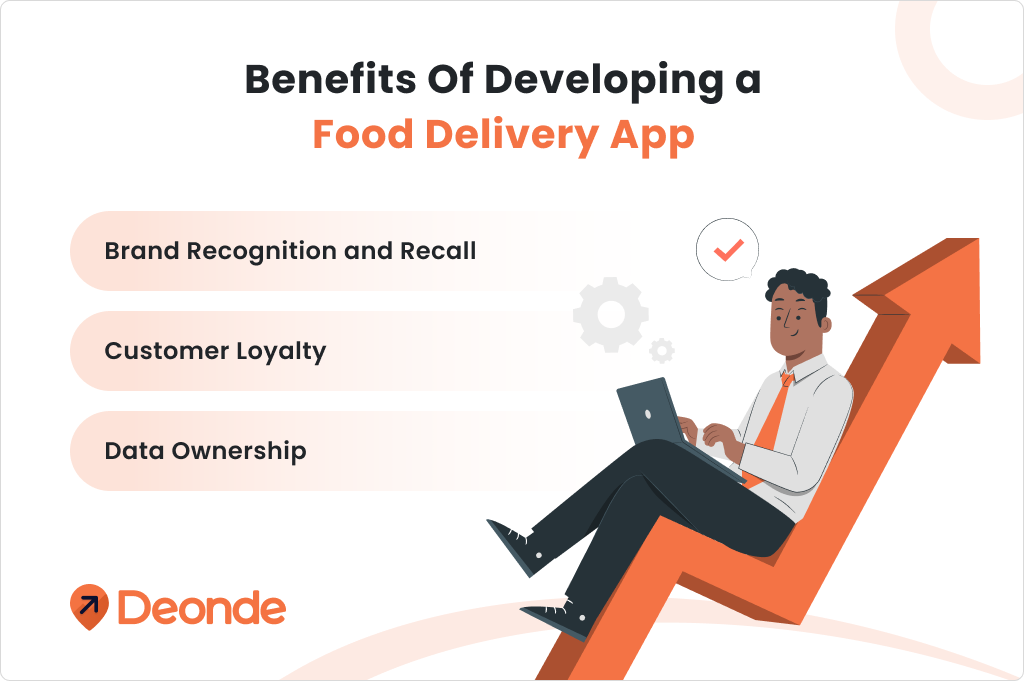
Developing your on-demand food delivery app means taking charge of your finances, branding, and growth. The food delivery app business can generate massive revenue if done right.
Along with financial gains, there are several other advantages to developing your on-demand food delivery app:
1. Brand Recognition and Recall
Owning your app means owning your brand identity. By offering seamless experiences to the users, your app has the potential to become a popular household brand. Use this brand familiarity to scale your startup to new geographies. Besides, a successful brand is a valuable asset in itself!
2. Customer Loyalty
By keeping your interface transparent and trustworthy, you can grow and nurture a dedicated customer base who will always prefer your app over the competition. Building a loyal clientele can open up opportunities to upsell like express deliveries or premium subscriptions.
3. Data Ownership
Being the owner of your app means you have full access to important data sets and insights. You can examine daily orders, delivery timings, ratings, reviews, customers’ online behaviors, and more. Leverage these analytical insights to improve your food delivery app.
How Much Does it Cost to Develop a Food Delivery App?
Food delivery apps are a bit complicated to develop.
You need to develop four different types of apps, one for each stakeholder: the user app, restaurant vendor app, delivery driver app, and the admin panel.
Due to the complex nature of food delivery, apps may cost you anywhere from $15,000 to $45,000. Again, these numbers depend on the type of features, elements, design, choice of platform, integrations, and more.
Maintenance costs, server fees, and tech support wages will be paid to top these off.
As an entrepreneur who wants to boot-strap their On-demand Food Delivery Business Plan, developing an app from scratch can be expensive. This is why we recommend exploring SaaS-based food delivery solutions. You can get started with customizable solutions for under $100/month!
With constant tech support and round-the-clock updates, choosing a customizable on-demand food delivery app will be the wisest move for your food delivery startup.
Choosing a Saas-based Food Delivery App Solution
A successful food ordering and delivery business begins with a robust, user-friendly, feature-rich food delivery app.
By now, you must have understood the nuances of building a food delivery app from scratch. There are too many things to monitor; it takes a lot of time and is expensive.
Hence, we recommend you invest in a SaaS-based food delivery app software like Deonde.
Why Go for a SaaS-based Food Delivery Solution like Deonde?
It’s a pre-built app, ready for deployment. With a few tweaks and changes, your on-demand food delivery app will be ready for launch in a matter of days.
It’s customizable. You can add features, elements, buttons, style, and layout to your liking.
White-labeling is affordable! Developing a food delivery app from scratch requires a lot of resources. On the other hand, SaaS-based white-label solutions like Deonde don’t need any hefty investments. Start with as little as $99/month!
Deonde’s white-label food delivery app is open to API integrations. It supports over 30+ payment gateways!
Deonde offers exclusive features like user role management, a call center dashboard, custom domain, vendor and driver settlements, and automatic driver allocation. With these modules, you’ll quickly outdo your competition.
Conclusion
Consumers today no longer want to dine in a restaurant. And why would they have piping hot food delivered to their doorsteps when they can?
Due to rapidly changing consumer habits, a huge online food ordering and delivery market has opened up. To start a business in this landscape, you need a comprehensive understanding of food delivery apps.
A food delivery app acts as a facilitator. It is the middleman, connecting consumers to the restaurants of their choice. To kick-start your food delivery business, you need an app. The food delivery app development process starts with intense research, wireframing, prototyping, integrations, testing, debugging, and final deployment.
If you think your work here is done, it’s certainly not! Updates, maintenance, and monitoring KPIs are always needed, even after the app is launched.
Hence, developing a food delivery app is not as easy as it looks. And that’s where we, Deonde, can help you. With our ready-to-use white-label food delivery solution, you can turn your dreams of becoming an online food delivery business owner into a reality.
Stop dreaming, start acting! Connect with Deonde today and launch your app this month!
Frequently Asked Questions (FAQs)
1. How Can I Build an Efficient Food Delivery App?
To make a food delivery app that works well, concentrate on improving the experience for users. Leverage functionalities like real-time GPS tracking, interactive menus, effortless payments, and push notifications to enhance user experience. Use advanced technology for route optimization, order management, and delivery allocation to improve the app’s efficiency.
2. What are the Challenges in Building a Food Delivery App?
Developing a food delivery app from scratch is a tedious process. It requires several months of coding and hefty upfront investments. Even during the development process, you must constantly customize the application to include standout features. After deployment, the app needs to be serviced and maintained. Developing a food delivery app ultimately demands extensive research and tech expertise.
3. Why Should You Build a Food Delivery App?
The food delivery app landscape is lucrative. The consumer demand for such apps is skyrocketing, and with a minor investment, you can launch a profitable business in this industry. Plus, the business of food delivery apps is easily scalable. Once you have the core functionalities and resources in place, it’s very easy to expand to more than one geographical area. You can also disrupt the industry by catering to specific needs, like offering vegan cuisines or partnering with cloud kitchens.
4. What are the Key Features of a Food Delivery App?
Every food delivery app must have standardized features like user registration, menu search & sort, payment gateways, add-to-cart, and live tracking. In addition to these, you can also have features like order and delivery management, in-app communications, performance analysis, driver tracking, social media integrations, and order scheduling.
5. How Do I Start an Online Food Delivery Business?
Kick-start your online food delivery business by connecting with Deonde, a customizable food delivery app development company. When you opt for a pre-built food delivery app, you save time, money, and resources. Besides, it’s easier to customize a white-label food delivery solution than to build one from scratch. Deonde offers feature-rich food delivery software solutions so you can quickly launch your online food delivery business.
6. What are the Benefits of Developing a Food Delivery App?
The online food delivery industry is booming and ripe for capitalization. With a low barrier to entry, you can easily establish a sustainable business in this industry. Developing a food delivery app can lead to many exciting opportunities for growth and revenue generation.
7. Do I Need Chatbots in My Food Delivery App?
It’s a modern food delivery approach where customers order and pay through a food delivery app. When their order is delivered, customers are notified through the app. After that, they can collect the order from their doorstep without interacting with the delivery driver.
